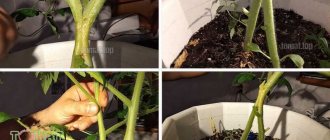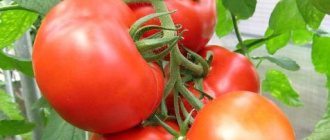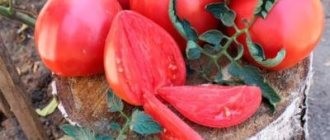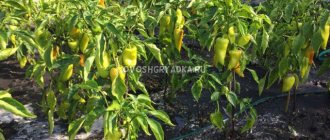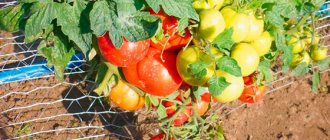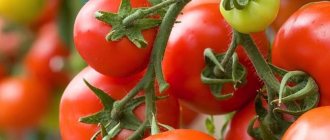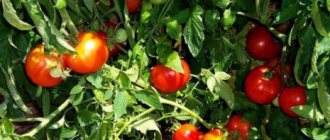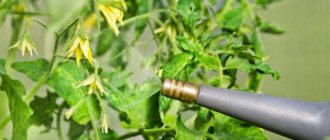The opinion is firmly rooted that tomatoes love water very much; without artificial irrigation there is no point in growing them. However, not every summer cottage has a source of water, not to mention a main water supply. Atmospheric precipitation is an unpredictable phenomenon; there is no point in counting on rain. Difficulties with watering often force summer residents to give up growing their favorite crops.
What is the essence of the method of growing tomatoes without watering?
Regular watering does not in any way stimulate the root system of tomatoes to develop - they are supplied with food and water regularly, often in excess. In such comfortable conditions, until the beginning of fruiting, there is no incentive for the plant to penetrate deeper with its roots. At the time of fruit development, the body’s needs increase - the roots begin to look for water and nutrition, i.e., the development of the root system occurs with a significant delay.
At this moment, growing the root system is a priority for the plant—fruiting is somewhat delayed, and the yield in quantitative terms is reduced.
To avoid this, there is an agricultural technique - growing tomatoes without watering; a developed root system is formed long before fruiting. Such roots can “nourish” not only the tomato bush itself, but also a rich harvest.
My doubts
I’ll admit right away: the new way of growing tomatoes in open ground seemed ridiculous. My husband said that I was wasting my time and energy. When the summer drought set in, the plants clearly suffered from the heat. The leaves were withering, I wanted to give the poor things something to drink.
I had a hard time containing my enthusiasm. I wanted to bring water from my dacha in buckets. After some time, everything returned to normal. The bushes turned green, the roots grew in all directions and became stronger.
I’ll admit right away: the author of the article advised not to water vegetables at all. I was unable to overcome the psychological barrier. I mentally divided the beds into two parts. I left one section like that, and carried buckets of water to the second section as soon as the ovary began to form en masse.
Compliance with the conditions is the main thing in the technique
According to all the laws of nature, “nothing comes from nothing.” It’s the same with tomatoes without watering: if you grow them with reduced water consumption, then the remaining conditions of the tomato garden should be at their best.
The soil
The absence of watering implies the abandonment of liquid fertilizers. This means one thing - the bed for growing tomatoes should be prepared with special care. For autumn digging for every 1 sq. m contribute:
- 7-8 kg (at least a bucket) of humus or compost;
- 0.5 l jar of ash;
- 150-200 g of nitroammophoska.
Rich in nutritious humus, structured soil is the key to the success of tomato farming without watering. The rule applies to both open ground and greenhouses.
It is preferable to fertilize sandy soils during spring digging, so that all the applied fertilizers do not literally go “into the sand.”
Loams retain moisture well - in well-fertilized areas, tomato bushes do well without watering, starting from the moment of planting. If there is a clear lack of nutrition, one-time abundant watering with fertilizing is allowed.
The Prohibition Law can also be broken once during a particularly long drought.
What varieties of tomatoes to choose
Oddly enough, no special preferences are required when choosing a tomato variety. Feel free to experiment with your favorite varieties. The only limitation is that summer residents of the North-West must remember that the period of active fruiting is postponed by 10-14 days.
- Since part of the stem is used to form the root system, there is no point in planting determinate varieties.
- Medium-sized varieties optimally correspond to agricultural technology for obtaining a tomato crop without watering. For an open ground bed, it is better to take varieties of early or mid-early ripening: “King of the Early”, “Bogatyr”, “Cossack”, “Adeline”, “Gina” and many others.
- Without exception, all varieties of greenhouse tomatoes are suitable for growing tomatoes in protected soil: “Darenka”, “Dietary Healthy”, “Hurricane F1”, “Fairy Gift”, “Search F1” and others.
Without watering, salad tomatoes are also suitable for canning; ground and greenhouse tomatoes bear fruit, produce a satisfying harvest, and have a rich taste.
Country stories
My family loves homemade food. Canned pickles, salads, and snacks are not served on the table in winter. I grow vegetables both in a greenhouse and in open ground. I think that I have gotten the hang of this difficult matter. Little tricks help:
- When the temperature drops, I water only manually with warm water.
- In hot summers, I increase the number of approaches to 2 times a day (morning and evening); on rainy days, I leave the tomatoes until the soil dries out.
- I grow seedlings of elite varieties in a greenhouse using a drip irrigation system.
- The X-Hose hose has become a faithful assistant in caring for adult plants. Lightweight, gives good water pressure, does not wash out roots.
Tomatoes without watering - plant according to the rules
The method of obtaining a crop without artificial irrigation will save a lot of time, effort and money. To fully experience the benefits of the method, you must follow certain rules of agricultural technology.
How to prepare seedlings
Tomato bushes should be prepared for growing without watering from the moment they emerge. Young plants are accustomed to lack of moisture from the first days of life. Watering is carried out only if the sprouts wither, preferably through a tray, in order to stimulate the growth of roots into the depth of the container with soil.
Advantages of this mode:
- seedlings do not stretch;
- the root system develops;
- a dry microclimate in a seedling box is the best prevention of blackleg and other dangerous diseases.
An important point - when diving seedlings, you should not pinch the root. The root system of a tomato bush can penetrate 1.5-2.0 m deep.
When they reach the age of 50-60 days, the seedlings are planted in open ground or in a greenhouse. For better survival of plants during transplantation, it is necessary to follow a step-by-step sequence of operations.
The bottom pair of leaves of each plant is removed before planting. The bare section of the stem will be needed to form adventitious roots.
Try to keep the earthen ball on the roots - this will speed up the acclimatization process in the new place. If the roots of the seedlings are bare, prepare a clay mash with the consistency of liquid sour cream. Seedlings are dipped in mash until the middle of the stem before being placed in the hole. This ensures maximum contact with the ground.
Preparing the hole
You can’t count on a special tomato harvest without fertilizing - you need to add the following to each hole:
- 4-5 kg of compost or humus without mineral fertilizers;
- 1-2 handfuls of wood ash;
- 1 g pharmaceutical potassium permanganate;
- ½ bucket of water.
Water should be poured into the hole only after mixing all the fertilizers with the soil - the composition must be averaged according to the concentration of the elements.
After absorbing water, the seedlings are laid horizontally with their tops facing north. Up to the middle of the length, the stem is sprinkled with soil, in a layer of no more than 5 cm. It is in the surface layers of the bed that beneficial microorganisms live, which enter into symbiosis with the seedlings.
First and last watering
Carefully pour another ½ bucket of water under the root, being careful not to wet the leaves. This is where the watering ends. Mulch the bed with straw, grass, sawdust - any bulk materials to reduce water evaporation and protect against weeds. The mulch layer should be at least 5 cm
The top of the seedling can be tied to a support or trellis. The holes are placed at a distance of 40-50 cm in rows with row spacing of 80-100 cm. Tomato bushes should receive enough sunlight.
The main thing is not to show pity and not to water the garden bed after 2-3 days, when the water in the hole is used up and the tomatoes begin to wither. A lack of water will accelerate root formation on the horizontal part of the stem - in 1-2 weeks everything will return to normal, the seedlings will “come to life”.
In the video you can see how tomatoes grow that were not watered, not fertilized, and no growing technology was followed.
LiveInternetLiveInternet
Secrets of growing tomatoes without wateringSecrets of cultivation
Could this even be possible? After all, we know that things cannot grow without water. Therefore, the plant receives nutrients from the soil through the movement of liquid. Plant cells also need moisture. It turns out that its quantity can be reduced to a minimum and at the same time get excellent tomatoes from your plants. An experienced gardener shares his latest secrets and tips in the TV show “Successful Tips”.
The owner's greenhouse, or rather, the tomatoes in it look just wonderful.
Long stems up to the ceiling are hung with fruits. And I can’t even believe that everything is supported by minimal watering. The secret lies in growing seedlings. All you need is a piece of film and a box that you have left over from cookies or something else. You can simply make boxes and cover them with film or come up with your own design. After all, as we know, our gardeners are great inventors and jacks of all trades. Watering tomatoes is carried out by obtaining cups with a solution of Uniflor chelate fertilizer. This is where the food will come from. What to do with the evaporation of liquid by the leaf surface. Very simple . In "Successful Advice" they advise gardeners to pick off the leaves. The first ovary has been established; tear off the leaves attached to it. A second one has formed, cut it off from below. And so on . Cover the surface under the plants to prevent moisture from evaporating. That's all the secrets. Everything is simple and accessible to everyone. — This often happens, we go to the dacha to relax, which means we work all summer. Weed, feed, water. You can't go anywhere without this. It turns out not. Today we will learn how to get a rich harvest and do almost nothing. Galina Aleksandrovna, you have such a harvest of tomatoes. But you say that you don't water them. How do you manage to do this? - You see, the secret is very simple. About 1/3 remains here. After all, we have been eating these tomatoes since mid-July. The trick is that I grow seedlings in a special way. How is this done? You take a piece of film about the size of a notebook. You do the following. Take a tablespoon of prepared soil and pour it into this upper left corner. Then take the tomato seedlings (I’m not showing in the tomato) and place them like this so that the cotyledon leaves are above the edge. Then you take another tablespoon of damp soil and sprinkle it on top. Fold the bottom, roll up a cylinder like this, put on an elastic band so that it all doesn’t fall apart. And put everything in a box, just without a hole. And about 9-10 pieces fit here. And here they grow. From the teapot here (in the film) you water it not with water, but with a weak fertilizer in chelated form (Uniflor). What's the secret . As soon as you have the first bone, all the leaves are removed from it. The second one has started - again the leaves are removed from it. And so on . You see that the leaves are only left at the top. After this, the moisture from above must not be allowed to evaporate. That's why I immediately cover the soil with newspapers. That's all. My job is to come and harvest. Of course, there is work involved in removing leaves and shoots, but watering is very limited. - This method of planting saves not so much energy, but also space. This greenhouse is only 18 meters long, but it feeds its owners and their friends all summer and autumn. My method of growing tomatoes without watering
A.A. KAZARIN GOOD tomatoes are grown starting from planting seedlings in the ground. Because the main success is ensured by the seedlings as they are planted.
The value of the method I propose is that it allows you to grow a good harvest even from frail or overgrown seedlings. Another advantage of the method is that tomatoes are grown with virtually no watering from planting to harvest. And this eliminates the most difficult work in care.
It has long been known: if you cut some shoot from a tomato plant, for example, a stepson, and bury it in the soil half the stem, water it with water to compact the soil and moisten it, then this stem will not dry out, but over time it will give roots and develop normally .
Why? Yes, because the buried part of the stem replaced the function of the root. This means that it is possible and necessary to make fuller use of this biological feature of the tomato when growing it.
WHEN PLANTING, I mentally divide the seedlings in half. I tear off all the leaves from the lower half (usually they break off easily), and dig an oblong hole-groove under the bush, a little more than half the length of the stem. I put half a bucket of compost in it.
I prepare compost without adding mineral fertilizers to its layers, so I add it as needed without fear of overfeeding. I add a handful or two of humus or manure, two handfuls of wood ash, a handful of superphosphate, and, if available, I gr. potassium permanganate.
I thoroughly mix everything with the soil of the hole. I pour half a bucket of water into the grooves. After absorbing moisture, I lay the lower part of the stem with torn leaves strictly horizontally.
I sprinkle a 3-5 cm layer of earth, no more. I tie the upper part of the stem almost at a right angle to the driven stakes, or, subsequently, I tie it to the trellis. I pour another half bucket of water on top.
After this procedure, it seems that only tomato tails are sticking out on the plot of land. That's all! After planting, I don’t water the tomato bushes throughout the entire season, until harvest.
At the same time, despite the scorching sun, the plants develop successfully, produce more, larger and better quality fruits compared to the control - plants with periodic watering. THE MEANING OF THE METHOD is as follows. With periodic watering, even rare - once every one or two weeks, as most gardeners usually do - the plant has no incentive for the growth of the root system, right up to the start of fruiting.
They have enough moisture and nutrients for the development of the stem and leaf surface. In this case, the roots do not grow, because... Nothing useless happens in nature.
And the roots begin to develop intensively only at the moment of fruit filling, i.e. with some delay. As a result, fruiting is delayed and the yield is reduced. In the absence of watering, the roots begin to seek moisture as the soil dries out long before fruiting. They grow in all directions and, as a result, a powerful root system develops in a timely manner, capable of reliably feeding the plant not only during stem growth, but also during fruiting. In order to obtain maximum yields of tomato fruits, you can, of course, water the plants, but only after mass fruit set. However, I don't do this because... in this case, they become less fleshy, watery, similar to those grown hydroponically. I FORESEE that, after reading my recommendations, many will think: well, what’s so special here - and I bury part of the stem in exactly the same way when planting overgrown seedlings.
Initially I also did this with overgrown seedlings. But later I realized that it is necessary to plant any other seedlings in this way, even when picking a short one. Some gardeners bury the stems, but place them at an angle in the ground. In this case, the main root that has already developed in the seedlings turns out to be at a depth of more than 10-15 cm.
With such deepening, it does not develop, is inactive and subsequently, after the formation of new surface roots, even dies.
This happens because the herbaceous tomato root lives only in close symbiosis (cohabitation) with soil microorganisms. Due to the latter, he feeds the plant and lives himself.
At a depth of more than 10 cm, the number of such microbes decreases sharply and deeper than 15 cm they are practically absent. And everything useless in nature dies, O root. Hence the unproductive expenditure of plant energy on the formation of new roots.
Time is wasted, and the effect that is achieved when the stem and root are strictly horizontally laid to a depth of 3-5 cm is not obtained.
And further. If you do everything like this, then why do you soon begin to water the planted seedlings? Because the matter here is somewhat more complicated than it seems at first glance.
THE FIRST TIME, after planting, the plants are pleasing to the eye and almost never wilt. Even in the sun. But then, when the soil dries out in the holes, the tomato bushes begin to suffer somewhat. And you see how their leaves shrink slightly.
The feeling is that a little more and they will begin to dry out. I just want to water them at this time. And a caring vegetable grower, of course, does not stand it - he gives the plants moisture. But in vain: the lover of life will not be lost! After all, what happens to the appearance of the plant is quite natural.
When the soil dries out, the plant struggles to survive and seeks moisture. The roots are growing vigorously. And this consumes energy and plastic substances, the need for which at this time is not yet fully replenished.
But after a little time (7-10 days) the tomatoes will get stronger and your pets will come to life and become like never before. From frail they turn into “palm trees”. Therefore, the owner also needs to overcome the psychological barrier.
And understand that plant survival is possible only when about half the stem is buried. When planted in the usual way, when only the root part is buried, the plant is not able to withstand prolonged drought.
AND NOW ABOUT THE DETAILS. Before planting seedlings in a greenhouse or greenhouse beds, I gradually accustom them to the outside air.
To do this, I take it out into the air or into a greenhouse for three to four days; on the first day, for 10-15 minutes, on the next - for 40 minutes, and in the next one or two days for 2-4 hours. Only after this can you begin planting. The timing of planting seedlings in a greenhouse is determined by the average daily outside air temperature. I define it for myself this way: I add up the minimum temperature (from weather reports) at night and the maximum during the day during the day and then divide their sum in half.
If within 3-5 days this average daily temperature begins to exceed 8 degrees Celsius, then you can safely plant the seedlings in a greenhouse.
The fact is that tomatoes begin to grow only at a temperature of +8 degrees, so the average temperature should not be lower. Stunting is a slow death for plants.
To prevent plants from suffering from cold (frost), I usually plant from April 15 to May 15. And in open ground (with tunnel shelter during severe cold spells and frosts) - from May 25 to June 15.
Again, the timing of planting depends not only on the outside temperature, but also on the volume of the unheated greenhouse or greenhouse.
The larger the volume, the less the impact of night frosts on the plants, the less risk of damage by them and, therefore, the seedlings can be planted earlier, and vice versa.
Immediately before planting, I always coat the SEEDLING ROOTS with liquid (like sour cream) clay mash, and additionally dust them with earthen dust. After which I plant. I do this even with seedlings grown with a clod of soil.
After all, on the surface of the coma there are always small root hairs, which can quickly dry out during transplantation. In the sun, 15 seconds is enough for them. I plant in the morning or evening hours before sunset.
I place the seedlings in the grooves when planting with the stems facing north and when emerging from the ground, not necessarily at a right angle (it can be broken). The top reaches towards the sun and gradually straightens.
At the same time, I do not take the seedlings with my hands by the bottom of the stem, but by its upper part or by the root, because otherwise, the pubescence (hairs) - the rudiments of future roots - is damaged.
When watering during planting, water should not be allowed to get on the leaves - the respiratory stomata on the leaves are clogged with moisture. The drops remaining on them in sunny weather act like magnifying lenses and from all this the plants can also wither.
ANOTHER ERROR is thickening the plantings. In small greenhouses, some gardeners strive to plant as many bushes as possible. And you need to arrange the plants so that the sun falls on each leaf throughout the growing season.
With partial darkening, it is better for tomato plants if it is well lit not in the first half of the day, but in the second half of the day.
The usual distance in greenhouses is 60 cm in a row and 70 cm between rows. For better illumination, I form tomato bushes into one stem. I make sure to pinch all the stepchildren the first time they appear.
I ALLOW the stem to branch only after the first flower cluster, if I see that the plant has become “fat.” I judge by the tops of the stems.
If they are thick, sometimes as thick as a finger, this means you urgently need to grow one or two additional lateral shoots. In this case, I form the plant into two or three stems. Otherwise, you won’t get fruit for a long time from fattening plants.
Do not pick leaves on plants. They are a factory with the help of which plastic substances and, ultimately, fruits are formed in the light. Only yellow and diseased leaves are picked off, as well as when thickened. Any loss of healthy leaves delays fruiting and ripening. Perhaps the only drawback of the method of growing tomatoes without watering is the need to remove leaves from the bottom of the plants when planting. Because of this, there may be a delay in fruit ripening compared to normal planting by 7-10 days.
But there is an undoubted gain in productivity and fruit quality. And the loss in the “race” can be compensated for in other ways.”
During flowering, I do not allow the temperature to rise above 30 degrees, otherwise the pollen will be sterilized and the flowers will fall off. To reduce the temperature on hot days, I ventilate the greenhouse.
The best self-pollination and fruit setting occurs with periodic shaking of the bushes. It is more convenient to do this when the bushes in rows are tied not to stakes, but to a trellis.
Fruit sets well when spraying flowers and leaves with a solution of boric acid (10 grams per bucket of water).
TO ACCELERATE THE GROWTH and ripening of tomatoes during the summer, judging by the condition of the plants, I apply mineral fertilizers. If the tops are thin and the flowering of plants weakens, a complex fertilizer is useful.
For example, ammophoska: a matchbox or a tablespoon in a bucket of water. Even better is a complex mineral fertilizer with a set of microelements: “Kemira Universal-2”, Art. spoon for 10 l. water.
If the tops are very thick (they seem to be double, flattened, more than 1 cm wide), I exclude nitrogen (saltpeter or urea) from the feeding.
NOTICED: plants respond faster to foliar feeding. Therefore, sometimes I take a sprayer and feed the bushes by spraying them on the vines. To feed plants with carbon dioxide, I place a barrel in the greenhouse, in which I fill grass or food waste with water for fermentation.
It has been established that an increase in carbon dioxide content leads to a directly proportional increase in the intensity of photosynthesis, and, consequently, to an acceleration of fruit filling and ripening.
Simply mulching the soil under the plants with black materials: peat, glassine, roofing felt, etc. can speed up the ripening of tomatoes by 7-10 days. To combat late blight, I use copper oxychloride (30 g per bucket of water) or polycarbacin (40 g per 10 liters of water). These drugs are more convenient to use than Bordeaux mixture, because they do not clog the sprayer and are less harmful to plants. If you overdose on Bordeaux, you can burn the leaves.
I spray three times with an interval of ten days, starting from the moment of massive fruit set. Sometimes I also lightly dust with ash between the rows of plants. The development of late blight is influenced by the material of the shelters.
Most summer residents make the mistake of glassing the side walls of greenhouses and covering the roofs with film. But you need to do the opposite. According to my observations, under a film roof, late blight appears on tomato bushes 10-14 days earlier than under glass.
When there is wind, cold condensation from the film falls onto the leaves and creates great dampness. In addition, annual replacement of film on the sides is more convenient than on roofs. And standard size glass, 40 cm wide and 3-4 cm thick, on the roof in winter is rarely pressed through and does not need to be removed. TOMATOES WITHOUT WATERING can be grown on any type of soil, with any level of groundwater. I have never seen similar analogues of the method anywhere in the literature. How did I get to this point, you ask? I just learn from nature. One day I went on vacation with my family to the south. We arrive, and the tomatoes are all red, like at an exhibition on the bushes, although they are in the grass. Nobody watered them, and the summer was unusually hot.
So I thought: is it possible to grow the whole season without such a labor-intensive operation as watering?
And the idea came - to deepen the stem in such a way that it would produce additional roots and be able to withstand drought. A.A. KAZARIN, Pskov. I brought tomatoes with watering.
It has become a common sight when in the summer summer residents, having arrived at their garden plots on weekends, first of all rush with a watering can to the greenhouses to water the tomatoes. This occupation, especially for older people, is quite exhausting; the return in harvest for this diligence is most often negligible. I suggest you familiarize yourself with the method that I learned and tried myself several years ago. The essence of the method is as follows. With periodic watering (even rarely - once every one or two weeks, as most gardeners usually do), there is no stimulus for growth in the planted roots of tomatoes, until the beginning of fruiting: moisture and nutrients for the development of the stem and leaf surface in the absence of fruit is enough. The roots begin to grow only from the moment of massive fruit set, i.e. with a significant delay. As a result, fruiting is delayed and the yield is reduced. In the absence of watering, the roots of the tomato begin to seek moisture long before the start of fruiting, grow in all directions, and a powerful root system develops in a timely manner, capable of fully nourishing the plant not only during the growth of the stems, but also during the period of fruit filling. The yield in this case is always higher than that of plants with watering. Of course, not everything here is as simple as it seems at first glance. During normal planting, especially in greenhouses and in hot, dry weather, the plants may not survive and die. But this is a rare exception. Let's do this experiment. Let's cut some shoot from a tomato plant, for example, a stepson, and bury it in the soil half the stem, pour water on top to compact and wet the soil. This stem will not dry out, over time it will give roots and develop normally. From what? Yes, because the stem itself (its buried part) replaced the functions of the root when planted. This means that we need to make fuller use of this biological feature of the tomato when growing it. What I am doing. Landing technology. 1. Preparation of the ridge. It’s better to prepare it in the fall. If the bed is not ready, then in the spring, as early as possible (at the end of April), make a “warm” bed with the preparation “Siyanie-3” (compost maturation accelerator). Make an oblong hole-furrow under the bush, a little more than half a stem long. Pour half a bucket or a bucket of EM compost into the furrow (compost is prepared with “Shine” preparations), and a handful or two of wood ash. If EM compost is not prepared, you can simply take good garden soil. And it’s good to water with “Siyanie-1” or “Siyanie-2” for earlier preparation of the soil for planting, suppression of diseases and rapid rotting of plant residues. Mulch the holes (cover with organic matter - tops, straw, etc.). To help the soil prepare faster, you can cover it with old film. After 2-3 weeks you can plant the seedlings. 2. Landing. Pour half a bucket of water into the grooves. When planting seedlings, tear off all the leaves from the lower half. After absorbing moisture, lay the lower part of the stem strictly horizontally, orienting the tops to the north. If I plant seedlings without a clod of earth, then I make sure to spread a clay mash, dipping half a stem into it, then dust the coating with dry earth (for better connection with the soil).
Sprinkle with a 3-5 cm layer of earth. I tie the upper part of the stem almost at a right angle to stakes driven in immediately (or subsequently tie it to a trellis). Pour another half a bucket of water under the bush from above, trying to avoid moisture getting on the leaves. That's all - I no longer water the bushes throughout the entire season, until harvesting. I only spray it with the preparations “Healthy Garden” and “Ecoberin” for better survival, endurance and health. It should be remembered that if you plant plants deeper, you will not get the effect of planting, since at a depth of 10-15 cm there are practically no aerobic microorganisms, and they mainly feed the plant. Be sure to mulch the beds with a thicker layer (5-10cm), then dew will fall under the mulch and there will be no need to loosen the soil after rains. The first time after planting, the plants are pleasing to the eye, they hardly wither even in the sun. But then, when the soil dries out in the holes, you see how the tomato leaves shrink slightly. I just want to water them at this time. And a caring vegetable grower, of course, cannot stand it - he gives the plants moisture. But in vain. After all, what happens to the appearance of the plant is quite natural. When the soil dries out, there is a struggle for survival. The plant seeks moisture, the roots grow vigorously, this consumes energy and plastic substances, which at this time are not yet fully replenished. But a little time will pass, your pets will come to life, get stronger and begin to please the eye. The value of the method I propose lies in the fact that it allows you to grow a good harvest even from the most seemingly worthless seedlings - frail or overgrown. After 2-3 weeks, any “dead” seedlings become like a palm tree. Their owner just needs to overcome a difficult psychological barrier and refrain from watering. Tomatoes can be grown without watering in any type of soil with any level of groundwater in the area. Sometimes, in some greenhouses with muddy soil, the soil dries out and turns to dust. In such places, even the weeds dry out. Here sometimes, about once a month, you still have to maintain the planted plants with moisture. In general, if you want to get the maximum yield of tomatoes, then you can start watering them no earlier than at the moment of massive fruit set, when the plant’s root system has already largely formed. But I still don’t water them, otherwise the fruits become watery and less tasty. And even without this, so many tomatoes grow that we process them only for juice, and the harvest is enough for the family for the whole year until the next harvest. Comments. This method is very convenient for those who still plant a lot of tomato bushes. Time is spent only on preparing the bed and planting. With this method, after 2 weeks fruiting should begin, but with spraying once a week with the preparations “Shine”, “Ecoberin” and “Healthy Garden”, I do not observe this. The fruits grow a little smaller than with watering, but much more of them are set, they are stored better and are much tastier. The main thing is to provide food during planting and add mulch several times a season: dry and slightly wilted grass. Spraying with the preparations “Shine”, “Ecoberin” and “Healthy Garden” not only increases productivity, but also protects against unfavorable conditions and is a prevention of all kinds of diseases. The preparation is very simple - 1 tablespoon of “Shine” and 10 peas of “Ecoberin” and “Healthy Garden” per bucket. And you don’t have to spend the whole summer with buckets. Chesnokova Irina Anatolyevna (modified method of A. Kazarin)
Watering.
The basic rule of watering is to start watering no earlier than one hour after sunrise, and end no later than three hours before sunset. The quality of irrigation water is very important. Water with a low salt content should be used for irrigation. With each watering it is necessary to apply dissolved fertilizers. For drip irrigation, it is necessary to use completely water-soluble fertilizers. The composition of the nutrient solution depends on the period of plant development. In the initial period of growth of a tomato plant, more phosphorus is needed for the formation of the root system and nitrogen for intensive biomass growth. In the future, for better flowering, fruit formation and intense coloring of fruits, an increased potassium content in the irrigation solution is necessary.
Features of mulching
When wondering how to grow tomatoes without watering, special attention should be paid to mulching the soil. This is necessary to provide the root system with additional moisture.
Each layer of soil performs its own specific functions: somewhere grass grows, somewhere its remains are located. Modern vegetable growers are very accustomed to open soil and do not pay any attention to its other layers, because weeds do not interfere at all. Since the openness of the soil is directly related to natural conditions, such as sun rays, wind, precipitation, this often leads to drying out of the earth.
Most summer residents advise lightly loosening the top layer of soil rather than digging it. This should be done as needed. For example, by digging the soil deeper than 5 cm, you transfer the bottom layer to the top. Along with it, various microorganisms and worms appear at the top.
Being above the required level, they die due to lack of oxygen, and it takes a lot of time to restore the microflora. Please note that digging up the soil every year reduces the yield.
Why take unnecessary actions and reduce the amount of harvest if you can take a simpler path: it is enough to mulch the soil, preventing the soil from drying out. Moreover, this method is a budget option that will take very little time.
Absolutely any materials are suitable for mulching: newspaper, hay, straw, weeds, sawdust, fallen leaves from trees or expanded clay. The layer of mulch is about 20–30 cm. Be prepared that it will be necessary to add or change it during the season, since the mulch constantly sags.
According to the observations of one of the gardeners: “This is not the first time I have grown tomatoes without using water. I can say that this is a wonderful method. Caring for tomatoes does not require much time, and the fruits themselves grow tasty and sweet.”
It is very simple to grow tomatoes without watering, following the successful advice of summer residents and gardeners. Do not water the plants under any circumstances and follow simple rules for caring for tomato beds. Have a good harvest!
Preparing beds for tomatoes
In early spring, prepare the arches and covering material. In the first half of summer, crops need to be covered not only with film, but also with thick spunbond (preferably several layers), and in July-August polyethylene is sufficient.
Set aside the very top part of the garden for tomato beds, where the sun is a frequent “guest” and the moisture does not stagnate. In April, carefully dig up the soil, add humus or rotted compost into it and water it with hot water. Install wooden borders along the edges of the beds. This is a good way to organize warm beds.
In the southern regions, tomatoes can be grown in ordinary beds, but in the northern regions, to get a rich harvest, it is better to build warm ones.
Level the soil with a rake and make a small depression in the center along the bed. Then mark the places where the holes will be located. At the same time, maintain a distance of about 40 cm. Cover the bed with mulch film and make holes in the designated places.
Nuances of moisture conservation
There are many agricultural practices aimed at both more intelligent use of liquid by plants and saving water in the soil. A reasonable soil treatment system is of great importance. From the point of view of moisture conservation, fall plowing has a significant advantage over spring main cultivation. It is recommended to plow with a plow without a harrow, as well as other auxiliary tools, in order to create a ridge-like structure of the soil surface. At the same time, good conditions are formed for the retention of snow masses on the fields, better absorption of rain and melt water.
If there is a gap of more than one week between harvesting the previous crop and plowing, it is rational to immediately carry out surface treatment (loosening, peeling) immediately after harvesting in order to preserve agro-soil liquid reserves. Early in the spring, as soon as the soil reaches the state of so-called “physiological ripeness,” the surface layer is loosened (“covered with moisture”) with a combination of heavy or medium-sized tooth harrows. As a result of this treatment, the capillary structure is broken and the liquid is drawn up through the capillaries, as well as its volatilization.
When growing crops without irrigation, it is necessary to limit deep cultivation with soil mixing to the required minimum and, if necessary, increase surface cultivation. Shallow loosening is carried out after precipitation has ended, as well as the formation of a soil crust, by breaking it, again, you can get rid of unnecessary capillary extraction of moisture from the lower layers. A similar function is carried out by both continuous harrowing (pre- and post-emergence) and inter-row tillage.
Deep inter-row cultivations are not recommended not only for reasons of fluid conservation, but also to prevent damage to the root system, which, under conditions of unstable or insufficient moisture supply, is slowly restored and initiates a delay in the formation of the entire plant. Hilling up plants should be done only when the soil moisture is high, or it should be abandoned completely.
Features of care
Although care for vegetable crops is minimal, tomatoes still require certain conditions. When planting tomatoes in open ground during the drying period of the soil, it is important not to water the bushes. Get over yourself!
The unkempt appearance of the bushes is explained by the fact that the roots in the soil begin to seek moisture, which requires a large amount of energy. After a half-moon, the plant again takes on a fresh and fragrant appearance.
The traditional method of growing tomatoes without watering is the complete absence of water during the development of bushes. However, if you are very worried about the tomatoes, it is not forbidden to water the garden once a month during fruiting. Then be prepared for the fruits themselves to become watery. In the absence of watering, tomatoes have a sweetish taste; the fruits can be used in the preparation of salads or various tomato products.
In order for a plant to grow healthy in a greenhouse, you need to know several features of its cultivation:
- Form beds correctly.
- Remove the lower leaves on the stem.
- Perform stepsoning.
- It is recommended to add carbon dioxide to the seedlings 2-3 times, for example, a Greenhouse tablet.
- Provide high-quality lighting in the greenhouse, you can even add an additional lamp.
- It is necessary to systematically ventilate the greenhouse, especially in hot weather (above 30 °C).
- Water the seedlings only in exceptional cases, when fruits appear on the bushes.
How to plant tomatoes correctly so that they grow without watering
When growing tomatoes without watering using the Kazarin method, the most important thing is the correct transplantation of already prepared seedlings. This can be done with an earthen lump using the transfer method, or without it (not acceptable after watering)
When planting seedlings without a soil ball, I first make a clay mash. Half the stem needs to be dipped in this mixture so that the connection with the soil is stronger - I lightly sprinkle it with dry soil.
When I plant tomato seedlings so that they grow without watering, I use a fairly effective technique:
- I tear off absolutely all the leaves;
- I dig a groove under the plants (for 3-4 bushes, at a distance of 25-30 cm) with a depth of no more than half the plant stem.
- I pour compost there - about half a bucket per bed (my mixture does not contain layers of fertilizers, thereby eliminating overfeeding);
- I sprinkle with ash - no more than two handfuls per furrow, mix a little;
- I dissolve 2 grams of potassium permanganate (can be replaced with iron sulfate) in a bucket of water;
- then, little by little, I pour half a bucket into each furrow. The water should be absorbed.
After this, I begin planting “lying down”: I place the seedlings horizontally in the furrow with their roots down. The tops of the plant should face north. I sprinkle the root part with a small layer of soil, no more than 3-5 cm. The main rule when planting is not to plant the plant deep, otherwise the effect will be the opposite.
I tie the upper part of the bush almost vertically to small, pre-prepared stakes. After this procedure, I pour half a bucket of water into each groove, while avoiding getting it on the leaves. We no longer water the bushes until the very moment of harvest.
Reviews
I learned about Kazarin’s method and decided to experiment. A small part of the seedlings was grown without watering, the rest of the bushes were grown in the usual way. As a result, after harvesting I was amazed at the difference in taste. The unirrigated tomatoes were very tasty and sweet, although they were slightly smaller in size than those grown with irrigation.
I decided to use Kazarin’s method at my dacha, since I don’t have time to go there often. I thought that nothing would work out and the seedlings would simply disappear. But the result exceeded all expectations. Even in the absence of constant care, the harvest turned out to be decent.
The method of waterless cultivation gives excellent results on all soils. It allows you to save time and labor costs, but still get a large harvest of delicious tomatoes.
Folk tricks for growing tomatoes in cold rainy summers
Sometimes in rainy summers tomatoes take on a bland, watery taste. To prevent this from happening, some gardeners sow basil nearby.
Popular rumor claims that proximity to this plant improves the taste of tomatoes.
Joint planting in a greenhouse, or Which vegetables can be planted nearby? Choosing suitable neighbors for vegetables grown in greenhouses, hotbeds, and tunnels.
Mixed plantings: choosing the best neighbors for plants Let's figure out which plants get along best with common garden crops.
If heavy rains and not at all summer weather have stopped the growth of your green pets, try digging them up with a lump of earth and transplanting them into containers without a bottom. Such containers should be placed in the garden bed and deepened to about 15 cm. Experienced gardeners claim that with this method of growing tomatoes in rainy summers they will feel much more comfortable. The soil in containers dries out faster, the roots of the plants will warm up well, but at the same time they will always be able to reach the necessary moisture and nutrients in the soil.
If you couldn’t save the harvest, don’t despair; perhaps next year will reward you doubly for your hard work. And this year, you can use the tops and roots of tomatoes to prepare an organic means of combating mites, aphids, caterpillars and sawfly moths.

